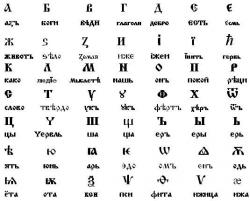|
| More than 300 million people today use Cyrillic alphabet: Russian and ànother 11 countries |
|
|
 Bulgaria is the birthplace of the Cyrillic alphabet, which was developed in Preslav and Ohrid Literary Schools during the tenth century. More than 300 million people from different countries today use the developed version of the Cyrillic alphabet.
Bulgaria is the birthplace of the Cyrillic alphabet, which was developed in Preslav and Ohrid Literary Schools during the tenth century. More than 300 million people from different countries today use the developed version of the Cyrillic alphabet.
The Bulgarian, or Cyrillic, alphabet was developed at the end of the 9th century AD for the Old Bulgarian language, also known today as Church Slavonic, at the Preslav Literary School and the Ohrid Literary School in the First Bulgarian Empire by St. Kliment Ohridski and St. Naum Preslavski. St. Kliment Ohridski and St. Naum Preslavski are two of the five disciples of St. Cyril and St. Methodius, the Byzantine diplomats and civil servants who invented the first Slavic alphabet, the Glagolitic, in 855 AD.
In 886 AD, The Glagolitic alphabet was brought to the First Bulgarian Empire by their disciples after they were chased away from the Central European kingdom of Great Moravia by the Catholic Germanic clergy. In Bulgaria, the disciples of the great Byzantine scholars, themselves Bulgarians, developed the new Bulgarian alphabet based on the Glagolitic, and allegedly called it Cyrillic in honor of their master, St. Cyril. Later Bulgarian clergymen, scholars, and missionaries spread their alphabet to other Slavic nations such as Russia and Serbia.
The Old Bulgarian language was the basis of Russian, Serbian, Slovenian, and Croatian variants and gained the significance of a universal literary Slavonic language. The modern Bulgarian literary language is characterized by dropping off the case forms, by the use of the definite article, by nine tenses, four moods, etc.
From Bulgaria, the Old Bulgarian literary language and the Cyrillic alphabet were transferred to Russia (the Glagolitic alphabet was also transferred there and used as cryptography) and the Serbian principalities, where during the 11-12th centuries Old Russian and Old Serbian literatures were born. The Cyrillic alphabet was also used in the lands of present-day Romania, which were under Bulgarian rule. After the Romanian principality of Wallachia became independent in the 12-13 centuries, the Cyrillic alphabet was still in use there, as in the principality of Moldova for several centuries more. À Bulgarian tombstone inscription from the 11th century (Here lies prince Presian …) was found even in the town of Michalovce, Slovakia.
The Bulgarian alphabet is a unique cultural invention that paved the way for the progress and development not just of medieval Bulgaria but also of much of the rest of Europe. Many believe that its proper name must be “Bulgarian” or “Bulgaric alphabet”, and that the name “Cyrillic” was promoted internationally during the Modern Age by Russia as the Russian Empire and later the Soviet Union would not admit under any circumstances that their powerful empire used an alphabet created by a nation which, regardless of its medieval glory, is much smaller and less influential in modern times. |
|
|
Source:
visitmybulgaria.com
|
| Tuesday, Feb 05, 2019 |
|
|
|
|
| » RENTALS |

|
|
|
| Commercial |
€ 1 000 |
|
| Location: |
Veliko Tarnovo |
|
|

|